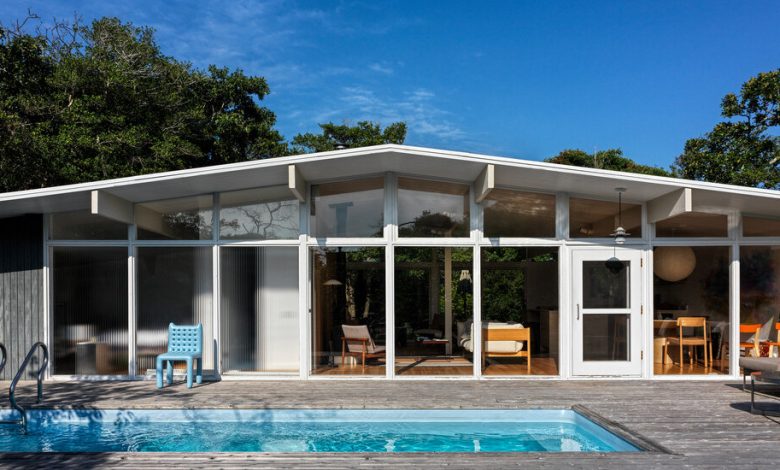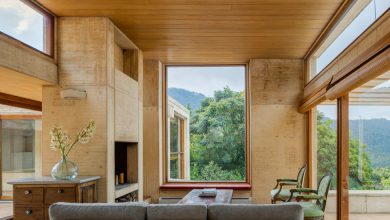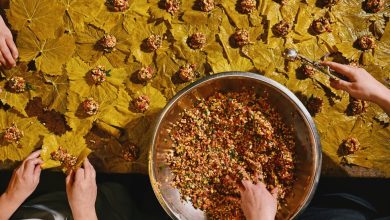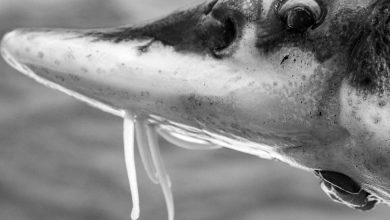On Fire Island, a Home for Art — and the Artists Who Make It

THERE’S A DISTINCT palette to Fire Island Pines, the gay beach getaway a two-hour train ride from New York City. Boxy houses and boardwalks made of untreated cedar have gone gray from the salt air. Pale sand dunes covered in sea grass and holly trees are muted against the men in neon swim briefs who wander through them. But one house stands out amid the uniformity: a modest, 1,100-square-foot white two-bedroom with a gently peaked roof, its walls filled with colorful contemporary art. Architecturally, it looks like it belongs in Palm Springs; its contents would be at home in any Manhattan gallery.
When the financial adviser Ilan Cohen, 56, found the property in 2021, he asked his friend the 38-year-old painter Doron Langberg to tour it with him. The two had become close a few years earlier, after Cohen bought a painting of Langberg’s for his collection of queer-focused art, which he’d begun acquiring around 2010. Both men had been renting shares in the Pines for many summers but, during the pandemic, Cohen decided to find a permanent escape where he could invite artists and others to stay in his guest bedroom. “It’s not about having art on the walls,” he says, “but about them having a place and creating something here.”
He immediately knew that this house was the right one: Its slim profile, inspired by the California midcentury Modernism of the American architect Joseph Eichler, had floor-to-ceiling glass windows at the front and back to let in light. The original owner had constructed it from a Sears catalog kit in 1959, making it one of the oldest dwellings on the east end of the island (which is technically more of a sandbar). When Cohen bought it, there were still remnants of a 1999 renovation, including jewel-toned laminate doors on the kitchen cabinetry. To update it, he hired Noam Dvir and Daniel Rauchwerger, a couple who also own in the Pines and are co-principals of the Manhattan architectural firm BoND (short for Bureau of Noam and Daniel). Like Cohen and Langberg, the designers began frequenting Fire Island after they moved to United States from Israel, where they were born and raised.
For more than a century, back when New York artists like Paul Cadmus and George Platt Lynes first came to summer here, Fire Island has variously appealed to queer creative types. When the renovation was nearly complete in the early summer of 2021, Langberg used the house to store his pigments, canvases and easels for painting trips to the nearby forest, known colloquially as the Meat Rack because men are known to cruise there. “I would hang all the paintings and Ilan and I would talk about them, and I would get ideas,” he says. With all the Hebrew being spoken, Rauchwerger, 36, likened it to a “kibbutz, but with fences.”
THE ARCHITECTS STARTED by stripping away the colorful finishes, then moved the stovepipe fireplace to the other side of the 600-square-foot main room to create distinct spaces for lounging and dining. Most of the overhead shelving and cabinets were removed, and kitchen appliances — including the refrigerator and freezer — were sunk low in an island and adjacent cabinets to create unobstructed sightlines and allow conversation to flow easily across the open floor plan. “We were trying to de-complicate and bring back the simplicity of the original idea,” says Dvir, 40. At the same time, Rauchwerger adds, “Modernism was quite rigid at times, so we introduced blurred boundaries.” Along one wall of the living area, they installed wood paneling at contrasting vertical and 45-degree angles in homage to Horace Gifford, the architect of many in-demand historic homes in the Pines. On the ceiling, a fresh coat of glossy white paint reflects aquamarine from a saltwater pool set into the front deck. The only areas left unchanged were the twinned bathrooms, with their royal blue tile and voyeuristic ribbed-glass wall, through which the adjacent showers are foggily visible to one another.
From the beginning, Cohen knew he wanted a mural behind his dining table. Langberg — whose luminous oil-on-canvas scene of two men reclining naked in bed together, “Lovers at Night” (2023), was recently acquired by the Metropolitan Museum of Art — had never painted one before, although he soon began experimenting with diluted acrylic, which would be less vulnerable to the island’s heat and humidity. Last summer, over the course of a single day, he completed an ethereal beach scene, depicting a view toward the sea from the Meat Rack, which adds a nearly eight-foot expanse of roiling color behind the round wood Harbour table. As Langberg says, “There’s something quintessential to the Fire Island experience of witnessing either moonrise or the sun coming up in the early hours of the morning after a night out.”
The mural keeps company with pieces by several other artists, many of them island regulars. A watercolor by the 38-year-old painter Stephen Truax, depicting a man tanning on the beach, hangs on the living room wall. At the back of the house, in the well-shaded primary bedroom, two early works by T.M. Davy flank the bed. One’s a 2012 painting of a single lit candle; the other a 2006 portrait of his partner, Liam Davy, the owner of the Pines-based landscaping company Gay Gardens, who planted the edges of Cohen’s property with native summersweet, blue vervain and hibiscus, some of which made their way into Langberg’s landscape paintings.
“Each person that shapes Ilan’s house is also someone who’s close to him,” the artist says. Dvir and Rauchwerger, whose clients are mostly L.G.B.T.Q, were especially proud to leave their mark on their favorite queer idyll: The project was their first in the Pines, and now they’ve begun work on their sixth. “You can’t take this place for granted,” Dvir says. “This renaissance we’ve seen in the last six or seven years has to do with people mortgaging their future and buying a place here knowing all of the complications.” During the AIDS epidemic, many residents of the Pines and neighboring Cherry Grove died, then the region became less popular in the late 1990s — there were simply too many ghosts lingering. Yet if the crowded bars and boardwalks this summer are any indication (not to mention last year’s “Fire Island” film), the vacation destination is busier than ever. This resurgence has come even as storms and rising sea levels have washed away much of the beach this year, portending an uncertain future.
Through it all, Cohen and his guests are holding steady. Langberg returned this summer along with other artists, including the painter Louis Fratino and the sculptor Oren Pinhassi, who all found time to dream up new work or just take a break. Come what may, art will always have a home here.





